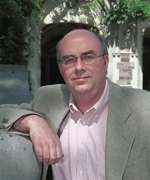Warren S. Warren
Warren Sloan Warren is the James B. Duke Professor of Chemistry and Director of the Center for Molecular and Biomolecular Imaging[1] at Duke University. He is also a Professor of Physics, Radiology, and Biomedical Engineering at the same institution. Warren is a deputy editor of the open-access journal Science Advances. He has contributed to the theory of Quantum Coherence as well as nonlinear optical spectroscopy.
Warren S. Warren | |
|---|---|
 Warren, 2002 | |
| Born | August 16, 1955 |
| Citizenship | American |
| Alma mater | Harvard University, AB University of California, Berkeley, PhD |
| Known for | Work in the field of Nuclear magnetic resonance and Nonlinear optics |
| Awards | William F. Meggers Award in Spectroscopy (2018) Liversidge Award (2017) C.E.K. Mees Medal (2015) Herbert P. Broida Prize (2011) |
| Scientific career | |
| Fields | Chemistry, Physics |
| Institutions | Princeton University, 1982–2005 Duke University, 2005–2011 |
| Thesis | Selectivity in Multiple Quantum Nuclear Magnetic Resonance (1980) |
| Doctoral advisor | Alexander Pines |
Scholarship
Warren began his career in the field of Magnetic Resonance where his work contributed to the revised understanding of the interactions between widely separated spins.[2] Warren would go on to exploit these "Intermolecular Multiple Quantum Coherences",[3] and this work helped lead to the development of new pulse sequences for magnetic resonance imaging with new types of contrast. His work in nonlinear optics developed a range of optical methods which exploit laser pulse shaping to image molecular content, including tissue and paintings.[4]
Students and Collaborators
- Donna Strickland (University of Toronto) [postdoc]
- Debabrata Goswami (Indian Institute of Technology)
- Yung-ya Lin (UCLA)
- Thomas Theis (NCSU)
- Howe-Siang Tan (NTU)
- Louis Serge Bouchard (UCLA)
Books
- Warren, Warren S. The Physical Basis of Chemistry Vol. 1 Academic Press, 1993 ISBN 0127358501
- Warren, Warren S. The Physical Basis of Chemistry Vol. 2 Academic Press, 2000 ISBN 0127358552
References
- https://web.archive.org/web/20111008012320/http://www.cmbi.duke.edu/. Archived from the original on October 8, 2011. Retrieved November 10, 2011. Missing or empty
|title=(help) - Weiss, Peter Ulrich, "Magnetic Whispers", Science News, Vol.159(3), p.42 (2001)
- "Intermolecular Multiple Quantum Coherence in Liquids" (PDF). Cs.duke.edu. Retrieved 2015-02-26.
- Wade, Lizzie (2014-01-21). "3D Imaging Reveals How Paintings Were Made | Science/AAAS | News". News.sciencemag.org. Retrieved 2015-02-26.